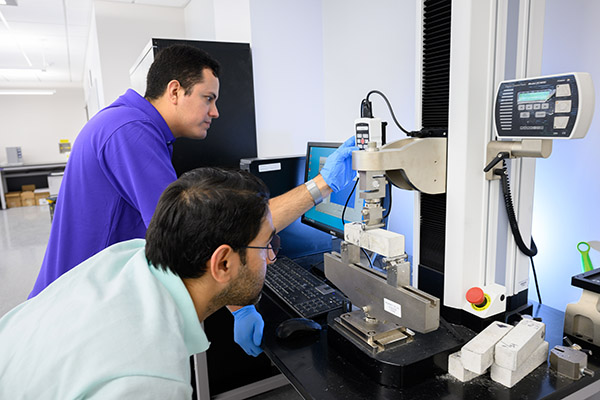LSU CM Faculty Continue Studies On Bendable Concrete
October 3, 2022
 BATON ROUGE, LA – According to research reports, concrete is the second-most used
substance in the world (after water) and is the most widely used building material.
Its usage worldwide is twice that of steel, wood, plastics, and aluminum combined.
However, the susceptibility of concrete to cracking proves to be a major challenge
since it results in the early deterioration of concrete structures.
BATON ROUGE, LA – According to research reports, concrete is the second-most used
substance in the world (after water) and is the most widely used building material.
Its usage worldwide is twice that of steel, wood, plastics, and aluminum combined.
However, the susceptibility of concrete to cracking proves to be a major challenge
since it results in the early deterioration of concrete structures.
LSU Construction Management Research Associate and Tran-SET T2 Coordinator Hassan Noorvand, along with other Bert S. Turner Department of Construction Management faculty, are developing a unique class of fiber-reinforced cementitious composites known as Engineered Cementitious Composites (ECCs), also known as bendable concrete. The LSU CM research team, which consists of Noorvand, LSU CM Professor Marwa Hassan, Louisiana Transportation Research Center Associate Director Tyson Rupnow, the University of California, and the Virginia Transportation Research Council, received a U.S. patent for the creation of ECCs. Its goal is to make ECCs more cost-effective and practical, thanks to three U.S. Department of Transportation research grants awarded to Noorvand.
The first of the three projects is to evaluate alternative sources of Supplementary Cementitious Materials (SCMs) for ECCs in transportation infrastructure. Due to their superior ductility and mechanical strength, ECCs have been proposed as a promising material alternative to extend the durability and infrastructure service life. Compared to normal concrete, ECCs use more cement due to the absence of coarse aggregate in the mixture design. The high cement content usually introduces higher hydration heat, autogenous shrinkage, and increased cost, as well as a greater negative impact on the environment due to the associated increase in primary energy and carbon dioxide emission used to produce it.
“A plausible solution would be to replace a large portion of cement in ECC with SCMs, also known as fly ash, without sacrificing its mechanical properties and tensile ductility,” Noorvand said. “As such, fly ash has become a key ingredient in the production of ECC materials and is the most utilized SCM in the U.S. cement and concrete industry. However, the decline in coal-fired power generation is affecting its wide availability. Consequently, there is an urgent need to find high-quality, cost-effective, and readily available alternative sources of SMCs.”
Noorvand and his fellow researchers will evaluate alternative sources of SCMs such as ground bottom ash, reclaimed fly ash, ground glass, and cement kiln dust.
The second project Noorvand’s team is working on is the characterization of regular concrete and low-cost ECCs with the incorporation of Cellulose Nanocrystals (CNS) and cost-effective ingredients. In researching alternative formulations and ingredients in the production of ECCs, the team implemented non-oil-coated PVA fiber as a replacement for oil-coated PVA fiber; used fine river sand to replace microsilica sand; utilized recycled crumb rubber and bagasse ash as a partial fine aggregate replacement; and used class F fly ash as a partial cement replacement.
“While practical and cost-effective ECCs have been developed using readily cheap resources, reduced tensile and compressive strengths of ECC materials are a major concern,” Noorvand said. “CNC is a special class of nanomaterials derived from cellulose, the most abundant natural polymer. CNCs have gained popularity due to their mechanical, chemical, optical, and rheological properties. In this study, we propose a modification of the microstructural properties of low-cost ECCs and regular concrete using cellulose nanocrystals. We believe incorporating CNC in ECCs can further help the implementation of readily available low-cost ingredients for optimum performance and cost.”
The third project focuses on the use of Calcined Clays (CCs) as an alternative to fly ash. CCs are a rich source of alumino-silicate species needed for both the pozzolanic reactions during the curing of OPC and the geopolymerization reaction.
“Preliminary results from a previously-funded Tran-SET project show that several readily available CCs are potentially useful as SCMs in concrete,” Noorvand said. “While these results are promising, further characterization of the CCs and their comprehensive evaluation in concrete is required to develop the necessary engineering knowledge for their use in the field.”
Until these projects are completed in the next year, the world will anxiously await the results, which could be a game-changer for construction locally, regionally, and nationwide.
Like us on Facebook (@lsuengineering) or follow us on Twitter and Instagram (@lsuengineering).
###
Contact: Libby Haydel
Communications Manager
225-578-4840
ehaydel1@lsu.edu